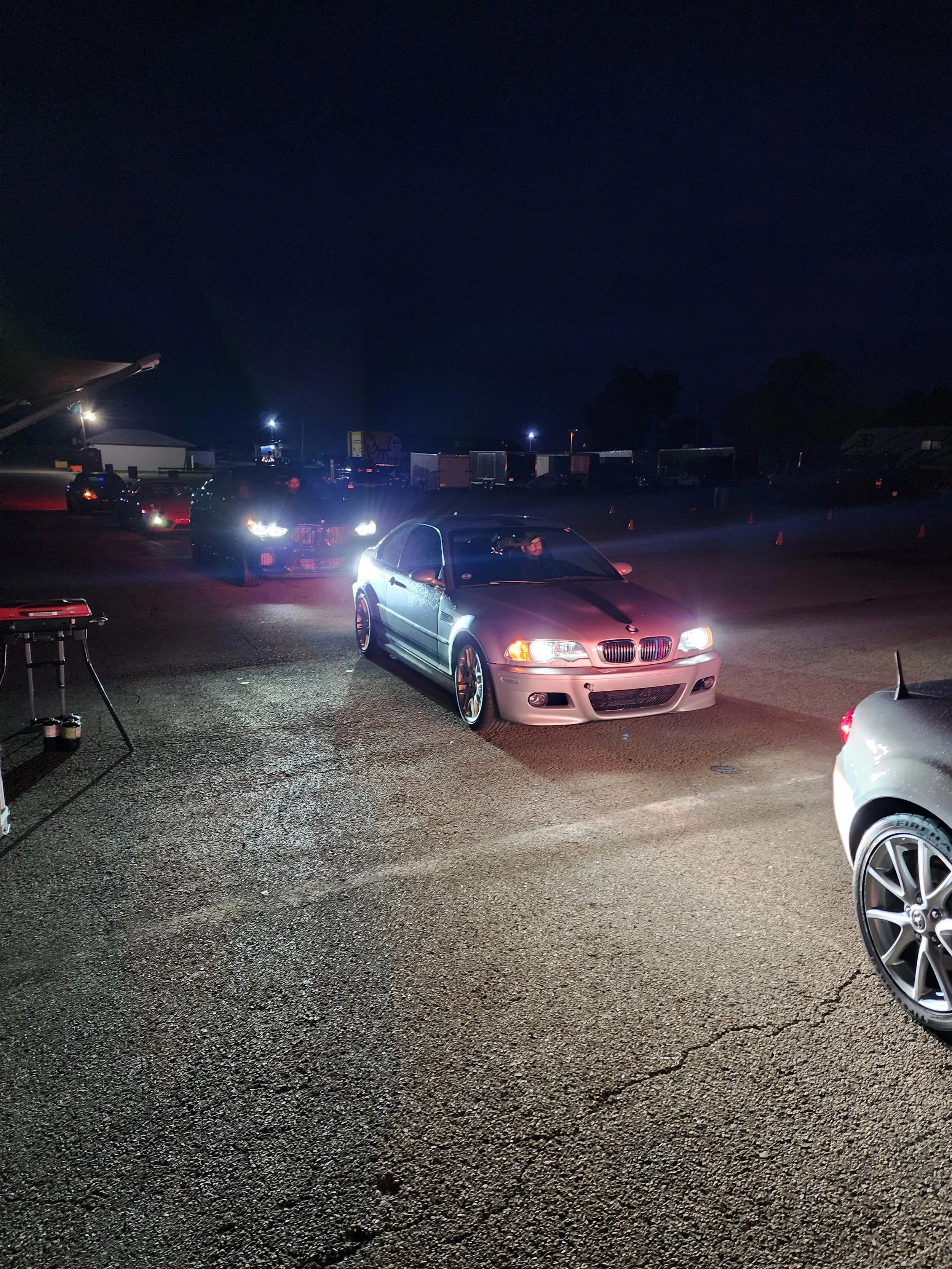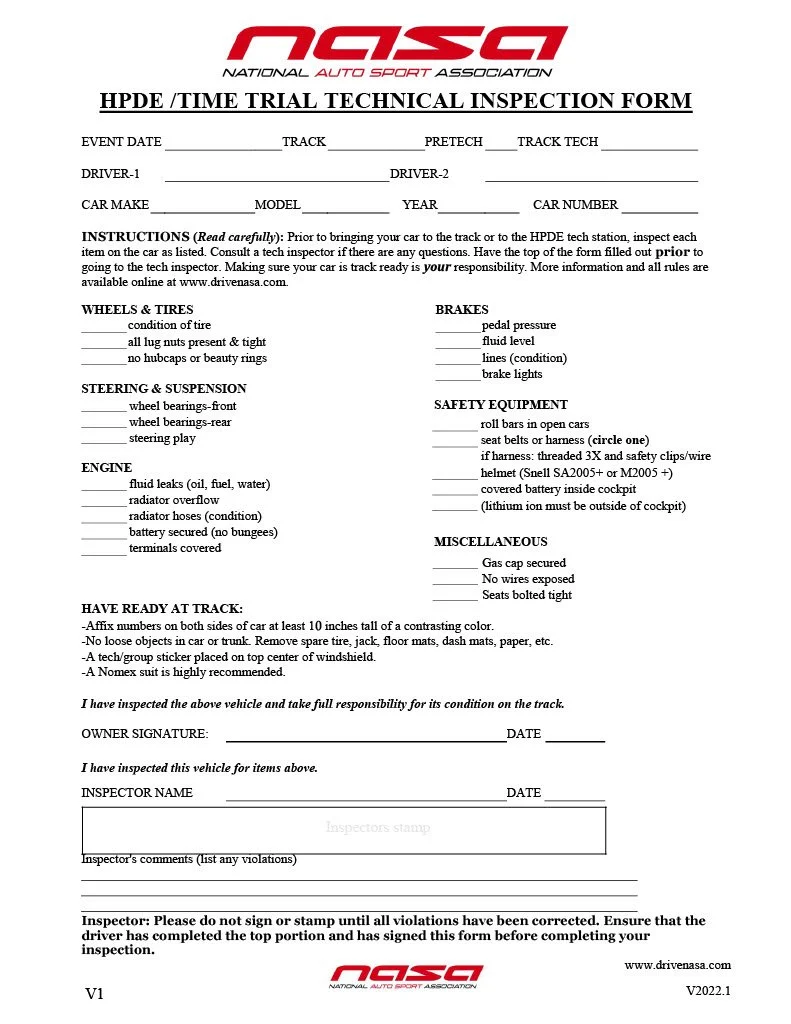The HPDE track day
It starts - early
The ‘early bird’ gets through tech inspection quicker and can claim a better spot to park. Some HPDE organizations do offer Friday evening tech inspections. Usually these groups have been running a non-HPDE event on that day - so check.
TECH INSPECTION - starts the day. Prior to the event you will have been told to fill out a detailed tech inspection form. Most organizations insist that the inspection is completed and signed by a licensed motorsport professional. This signed (original) form must be presented to the groups technical inspector(s) as you go through tech. The inspectors will do a ‘soft’ inspection of your car - checking brakes, wheels, fluids, body work, steering, suspension etc. They will also check you safety equipment, including harnesses and your helmet. These must comply with the specific rules of that organization - so check them.
Inspectors will also check that the car is completely free of any loose objects and the will check that the vehicle sports large visible numbers on both car doors, at least 10” tall.
After passing tech the appropriate stickers will be placed on the vehicle’s windscreen. These mark the group or groups the vehicle can run in. (Some cars are shared.)
Tech Inspection - the aim is to check if you and your vehicle is safe and viable to go on the track
The HPDE track day
It starts - early
The ‘early bird’ gets through tech inspection quicker and can claim a better spot to park. Some HPDE organizations do offer Friday evening tech inspections. Usually these groups have been running a non-HPDE event on that day - so check.
TECH INSPECTION - starts the day. Prior to the event you will have been told to fill out a detailed tech inspection form. Most organizations insist that the inspection is completed and signed by a licensed motorsport professional. This signed (original) form must be presented to the groups technical inspector(s) as you go through tech. The inspectors will do a ‘soft’ inspection of your car - checking brakes, wheels, fluids, body work, steering, suspension etc. They will also check you safety equipment, including harnesses and your helmet. These must comply with the specific rules of that organization - so check them.
Inspectors will also check that the car is completely free of any loose objects and the will check that the vehicle sports large visible numbers on both car doors, at least 10” tall.
After passing tech the appropriate stickers will be placed on the vehicle’s windscreen. These mark the group or groups the vehicle can run in. (Some cars are shared.)
Tech Inspection - the aim is to check if you and your vehicle is safe and viable to go on the track
Drivers meeting(s)
Read your schedule. Before any one HPDE student gets on the track, there will be general drivers’ meeting. This outlines the day, guidelines, emphasizes all rules, offers advice - everything that is critical to the days organization and operation.
Following this, the HPDE student will be guided to their appropriate run group meeting or directed to their instructor. (Often the instructors comes to find their student.)
Missing these crucial meeting can keep you off the track.
Be ready for the day
Track side essentials - what not to forget
First, pay attention to your schedule - most groups now have them online. Then do not missing any of your driver meetings - they exist to keep you informed and safe.
Claim a space to park your vehicle and your belongings. We recommend a pop-up tent, but if that is not feasible we suggest a tarp, container(s) for your stuff and a chair to relax in. Track days are long and very tiring.
Drivers meeting(s)
Read your schedule. Before any one HPDE student gets on the track, there will be general drivers’ meeting. This outlines the day, guidelines, emphasizes all rules, offers advice - everything that is critical to the days organization and operation.
Following this, the HPDE student will be guided to their appropriate run group meeting or directed to their instructor. (Often the instructors comes to find their student.)
Missing these crucial meeting can keep you off the track.
Be ready for the day
Track side essentials - what not to forget
First, pay attention to your schedule - most groups now have them online. Then do not missing any of your driver meetings - they exist to keep you informed and safe.
Claim a space to park your vehicle and your belongings. We recommend a pop-up tent, but if that is not feasible we suggest a tarp, container(s) for your stuff and a chair to relax in. Track days are long and very tiring.
The Grid
Grid run groups will have received their schedule by the event organizers. They are also announced prior to their formation on the grid. Organizers use various communication formats including texting. Usually you are allowed to grid at a minimum of 10 minutes before the session starts. First on the grid gets you first on the track.
How and where you grid will depend on the organization and the logistics of the track. It will be explained to you at your first driver meeting.
Track days are busy
Track group organizations have their own unique personalities. Some groups are more efficient than others since it is a ‘for-profit’ business. Others, are clubs and staffed by volunteers. Some groups are purely HPDE orientated while others want to introduce you to racing. Whatever the group, their priority will always be your safety then to enjoy the day.
We strongly suggest you try the different organizations and discover where you happily ‘fit.’
HPDE track organizers work very hard to keep to their printed schedule - but stuff happens, resulting in delays, curtailed sessions and even the cancellation of the session. Just be patient. AND always be diligent for any new announcements
The sessions will never run into the stated lunch hours. Grid, corners workers, all track personnel need a break and food, plus your respect.
Track Days are busy and very tiring, especially for first timers. Be aware of this. Try to relax between sessions BUT only after you have checked your car. Most important - retorqueing the wheels, checking tire pressures, brake pads and fluids Be safe. If you feel too tired before your session, it is OK to skip it. Track time needs all your focus. Keep hydrated, include electrolytes.
The Grid
Grid run groups will have received their schedule by the event organizers. They are also announced prior to their formation on the grid. Organizers use various communication formats including texting. Usually you are allowed to grid at a minimum of 10 minutes before the session starts. First on the grid gets you first on the track.
How and where you grid will depend on the organization and the logistics of the track. It will be explained to you at your first driver meeting.
Track days are busy
Track group organizations have their own unique personalities. Some groups are more efficient than others since it is a ‘for-profit’ business. Others, are clubs and staffed by volunteers. Some groups are purely HPDE orientated while others want to introduce you to racing. Whatever the group, their priority will always be your safety then to enjoy the day.
We strongly suggest you try the different organizations and discover where you happily ‘fit.’
HPDE track organizers work very hard to keep to their printed schedule - but stuff happens, resulting in delays, curtailed sessions and even the cancellation of the session. Just be patient. AND always be diligent for any new announcements
The sessions will never run into the stated lunch hours. Grid, corners workers, all track personnel need a break and food, plus your respect.
















